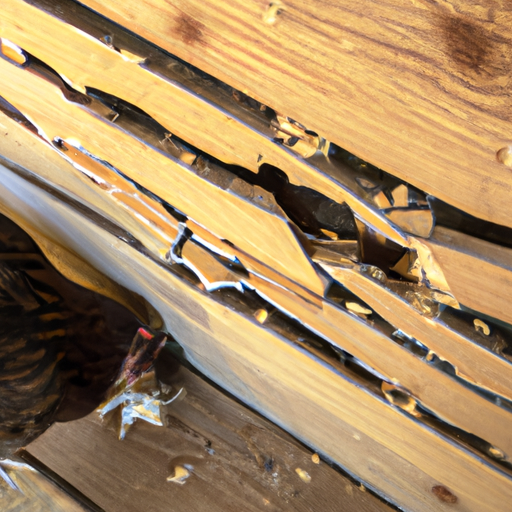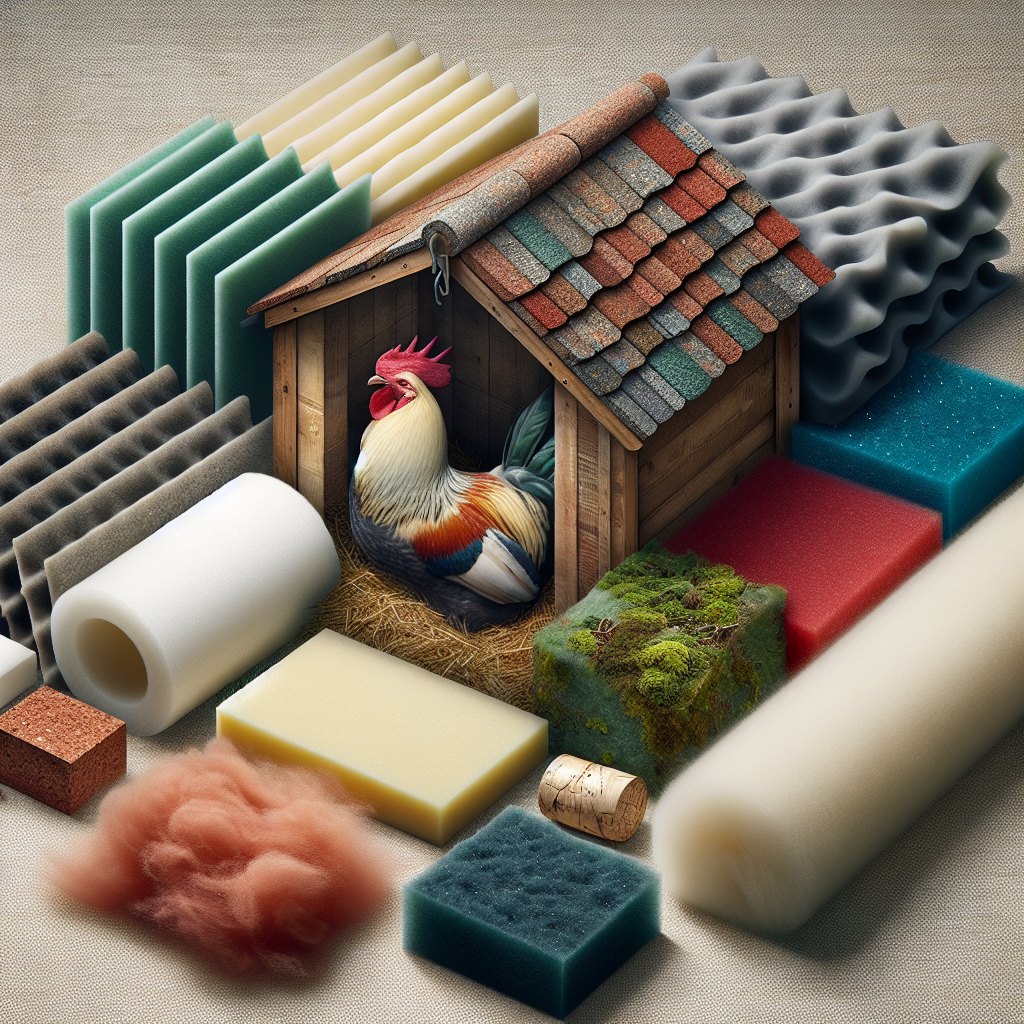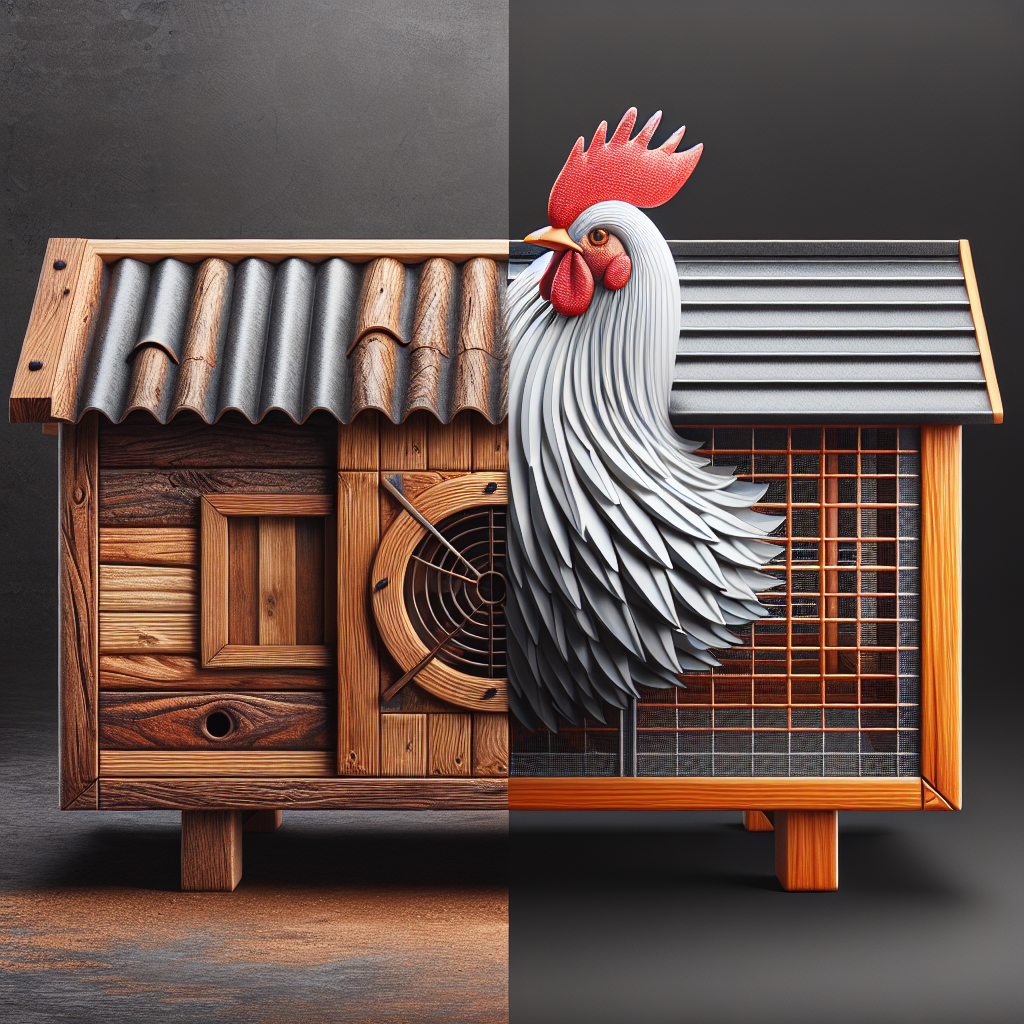In order to ensure the long-lasting durability of your coop, it is important to regularly assess and potentially replace materials. By keeping a close eye on the condition of your coop, you can identify any wear and tear that may compromise its structural integrity. This article will provide you with helpful guidelines on how frequently you should conduct assessments, and when it may be necessary to replace certain materials to maintain the durability and safety of your coop. So, let’s get started on keeping your coop in top-notch condition!
Regular Assessment
Signs of wear and tear
Regular assessment of your coop is essential to ensure its durability and the safety of your poultry. One key aspect of this assessment is to identify any signs of wear and tear. Look out for cracked or splintered wood, rust or corrosion on metal components, cracks or brittleness in plastic materials, and any mesh wire that is damaged or weakened. These signs can indicate that the materials are deteriorating and may need to be replaced.
Visual inspection
A visual inspection is an important part of assessing your coop’s materials. Take the time to carefully examine all components, paying close attention to any areas that are prone to damage or degradation. Look for discoloration, warping, or any other visible changes that could indicate a deterioration in the materials. By conducting a thorough visual inspection, you can identify any potential issues early on and take appropriate action to address them.
Functional analysis
In addition to a visual inspection, it is important to assess the functional aspects of your coop’s materials. This means evaluating how well the materials are performing their intended functions. For example, check for any doors or latches that are no longer secure, hinges that are rusty or stiff, or any other functional issues that might compromise the safety or functionality of the coop. By considering the functionality of the materials, you can identify areas that need attention or replacement.
Professional assessment
While regular assessments by yourself are important, it is also beneficial to seek a professional assessment from time to time. A professional can provide an expert opinion on the condition of your coop’s materials and offer recommendations for maintenance or replacement. They may have access to specialized tools or techniques that can provide a more thorough assessment. Consider consulting a professional if you have any concerns about the durability or safety of your coop’s materials.
Factors Affecting Material Durability
Climate conditions
The climate in your area can have a significant impact on the durability of your coop’s materials. Exposure to extreme temperatures, moisture, and sunlight can accelerate the degradation of certain materials. For example, wood may be more prone to rotting in damp climates, while plastic materials may become brittle and crack in intense sunlight. Understanding the specific climate conditions in your area can help you choose materials that are better suited to withstand them and implement appropriate maintenance practices.
Coop usage
The way you use your coop can also affect the durability of its materials. If you have a large number of chickens or other poultry, the increased activity and movement within the coop can put more stress on the materials. Additionally, if you frequently move or relocate the coop, the constant handling and transportation can cause wear and tear over time. Consider the usage demands of your coop when selecting materials and be mindful of any potential impacts on their durability.
Material quality
The quality of the materials used in constructing your coop plays a significant role in its overall durability. Opting for high-quality materials that are specifically designed for outdoor use and resistant to weathering can result in a longer lifespan for your coop. Investing in materials that are known for their durability, such as treated lumber or corrosion-resistant metal, can provide added peace of mind. Prioritizing material quality during construction or renovation can save you time and money in the long run.
Maintenance practices
Regular maintenance practices are vital for ensuring the durability of your coop’s materials. Simple tasks like cleaning, inspecting, and repairing can prevent minor issues from becoming major ones and prolong the lifespan of the materials. Regularly removing debris, checking for signs of damage or wear, and addressing any issues promptly can help keep your coop in optimal condition. Implementing a maintenance schedule and adhering to it will ensure that your coop’s materials are well cared for and can withstand the test of time.
Common Coop Materials
Wood
Wood is a popular choice for coop construction due to its natural aesthetic and insulation properties. However, it is important to consider the type of wood used and its resistance to rot and decay. Hardwoods such as cedar or redwood are known for their durability and resistance to pests and rot. Softwoods like pine are more susceptible to decay and should be treated or maintained regularly. Regularly assessing wooden coops for signs of decay, rot, or damage is crucial to determine when repairs or replacements are necessary.
Metal
Metal coops offer superior strength and protection against predators. However, metals can be prone to rust and corrosion, especially when exposed to moisture. Regularly inspect metal components of your coop, such as wire mesh or roofing, for any signs of rust or deterioration. Additionally, maintaining the paint or protective coatings on metal surfaces is essential to prevent rust formation. Addressing rust or corrosion early on can extend the lifespan of your metal coop and ensure the safety of your poultry.
Plastic
Plastic coops are lightweight, easy to clean, and resistant to pests and rot. However, prolonged exposure to sunlight can result in UV degradation, causing plastic materials to become brittle and crack over time. Regularly assess plastic coops for signs of UV degradation, such as discoloration or brittleness. Considerations for replacement should be made if the plastic becomes compromised and loses its structural integrity. Protecting plastic coops from direct sunlight or using UV-resistant materials can help prolong their lifespan.
Wire mesh
Wire mesh is commonly used for coop fencing, windows, or ventilation openings. Although it is durable, rust and corrosion can still occur, especially in humid or coastal climates. Regularly inspect wire mesh for any signs of rust or weakening. Ensure that the mesh is intact and free from any gaps or tears that could allow predators to enter. If any issues are found, consider replacing the affected sections of wire mesh to maintain the security and safety of your coop.
Wooden Coops
Expected lifespan
The expected lifespan of wooden coops can vary depending on various factors such as the type of wood used, climate conditions, and maintenance practices. On average, a well-maintained wooden coop can last between 5 to 15 years. However, poorly constructed or neglected wooden coops may require replacement sooner.
Signs of decay or rot
Regularly assessing wooden coops for signs of decay or rot is crucial for ensuring the safety and durability of the structure. Look out for soft or spongy areas, discolored wood, or a musty odor, as these can be indications of decay. Inspect the base, walls, and roof of the coop, as these areas are more susceptible to moisture buildup and rot.
Treatment and maintenance
Treating wooden coops with wood preservatives or sealants can help protect against rot, pests, and weathering. Regularly inspect the wood for any signs of damage or wear, and repair or replace any compromised sections. Apply a fresh coat of sealant or paint every few years to maintain the integrity of the wood.
Considerations for replacement
If the wood in your coop shows extensive signs of decay, rot, or damage that cannot be effectively repaired, it may be time for a replacement. Consider factors such as safety, structural integrity, and your poultry’s well-being when deciding whether to replace the entire coop or make necessary improvements. Investing in high-quality wood and proper maintenance can extend the lifespan of wooden coops.
Metal Coops
Expected lifespan
Metal coops can have a longer expected lifespan compared to wooden coops. With proper care and maintenance, a well-constructed metal coop can last 15 to 30 years. However, poor maintenance or exposure to harsh conditions can significantly reduce its lifespan.
Rust and corrosion
Regularly inspect metal components of your coop for signs of rust or corrosion. Rust can weaken the structural integrity of the metal and compromise the safety of your poultry. Treat any rust spots promptly by sanding, priming, and painting the affected area. Implementing preventative measures like regular cleaning and applying rust-resistant coatings can help prolong the lifespan of your metal coop.
Paint and coating maintenance
Maintaining the paint and protective coatings on a metal coop is essential for preventing rust and corrosion. Inspect the paint for any signs of peeling, cracking, or flaking, as these can allow moisture to reach the metal surface. Clean and reapply paint or coatings as needed to provide a barrier against rust formation.
Considerations for replacement
If a metal coop shows extensive rust or corrosion that cannot be effectively treated or repaired, it may be time for a replacement. Assess the structural integrity of the metal, as compromised sections can pose safety hazards for your poultry. Consider the costs and benefits of repairing versus replacing and choose the option that ensures the longevity and safety of your coop.
Plastic Coops
Expected lifespan
Plastic coops are known for their durability and resistance to rot and pests. With proper care and maintenance, a well-constructed plastic coop can last 10 to 20 years. However, exposure to UV radiation can weaken and degrade plastic over time, reducing its lifespan.
UV degradation
One of the main considerations for plastic coops is UV degradation. Prolonged exposure to sunlight can cause plastic materials to become brittle and prone to cracking. Regularly assess the plastic for signs of discoloration, fading, or brittleness. Implementing shade structures or using UV-resistant plastics can help mitigate UV degradation and extend the lifespan of your plastic coop.
Cracks and brittleness
Inspect plastic coops for any signs of cracks, brittleness, or other damage that could compromise the structural integrity. Pay close attention to high-stress areas, such as joints, doors, or windows. Repair or replace any damaged sections to ensure the safety and security of your poultry.
Considerations for replacement
If the plastic in your coop becomes extensively cracked, brittle, or compromised, it may be time for a replacement. Consider the overall condition of the plastic, its ability to provide adequate shelter and protection for your poultry, and any safety concerns. Proper maintenance, regular inspections, and using high-quality UV-resistant plastics can help prolong the lifespan of plastic coops.
Wire Mesh
Expected lifespan
Wire mesh is a common material used in coop construction due to its strength and ability to keep out predators. With proper care, wire mesh can last 10 to 20 years. However, exposure to moisture, rust, and damage can impact its lifespan.
Rust and corrosion
Regularly inspect wire mesh for any signs of rust or corrosion, especially in areas with high humidity or coastal climates. Rust can weaken the mesh, making it easier for predators to breach. Treat rust spots with rust remover and ensure the mesh is dry and free from moisture to prevent further rust formation.
Mesh integrity
Inspect the integrity of the wire mesh by checking for any gaps, tears, or openings that could allow predators to enter. Repair or replace damaged sections promptly to maintain the security of your coop. Consider reinforcing vulnerable areas, such as door openings or corners, with additional support to prevent wear and tear.
Considerations for replacement
If wire mesh shows significant signs of rust, corrosion, or damage that cannot be effectively repaired, it may be time for a replacement. A compromised wire mesh can compromise the safety of your poultry and enable predators to access your coop. Regular inspections, prompt repairs, and using high-quality mesh can help maintain the integrity and longevity of wire mesh in your coop.
Assessment Frequency
Annual assessment
Conducting an annual assessment of your coop’s materials is a good practice to ensure their durability. This comprehensive assessment allows you to identify any issues or signs of wear and tear that may have developed over the year. Pay attention to each material type in the coop, inspecting for any deterioration, damage, or compromised areas. By conducting regular annual assessments, you can address any arising concerns and plan for necessary maintenance or potential replacements.
Seasonal inspection
Seasonal inspections are important to account for any specific challenges or impacts that each season may have on your coop’s materials. For example, winter inspections can focus on assessing any damage caused by freezing temperatures or heavy snowfall, while summer inspections can address the potential impact of intense sunlight or high humidity. Tailor your inspections to the seasons and address any issues accordingly to ensure the durability and safety of your coop.
Ongoing monitoring
In addition to annual assessments and seasonal inspections, ongoing monitoring of your coop’s materials is crucial. Keep a close eye on any areas that are prone to wear and tear or susceptible to damage. Regularly check for any signs of deterioration or changes in the structural integrity of the materials. By continuously monitoring your coop, you can address any issues as they arise and take proactive measures to maintain its durability.
Post-weather event evaluation
After severe weather events, such as storms or heavy winds, it is important to evaluate the condition of your coop’s materials. Assess for any damage caused by extreme weather conditions and promptly address any issues. Check for loose or dislodged components, water damage, or structural weaknesses that may have resulted from the weather event. Conducting post-weather evaluations helps ensure the safety of your poultry and allows you to take appropriate actions to repair or replace any damaged materials.
Warning Signs
Structural weakening
One of the warning signs to look out for in your coop’s materials is any structural weakening. This can manifest as sagging or shifting of components, cracks in the foundation or framework, or any noticeable instability. Structural weakening can compromise the durability and safety of your coop, making it essential to address these issues promptly. Regular assessments and inspections will help you identify any signs of structural weakening and take the necessary steps to reinforce or replace affected materials.
Chemical degradation
Another warning sign to be aware of is chemical degradation of your coop’s materials. This can occur when materials are exposed to harsh chemicals, such as cleaning agents or pest control products. Look out for discoloration, fading, or deterioration in areas that have come into contact with chemicals. Chemical degradation can weaken the materials and make them more susceptible to further damage or failure. Proper handling and storage of chemicals, as well as using materials that are resistant to chemical exposure, can help mitigate this risk.
Excessive wear or damage
Excessive wear or damage is a clear warning sign that your coop’s materials are deteriorating and may need to be replaced. This can include significant cracks, breaks, or tears in the materials, as well as excessive warping, splintering, or rotting. Any materials that are visibly compromised or beyond repair should be promptly replaced to avoid potential safety hazards. Regular assessments and proactive maintenance practices will help identify and address excessive wear or damage before it becomes a significant issue.
Safety hazards
Perhaps the most critical warning sign to be vigilant about is any safety hazards present in your coop’s materials. This can include sharp edges, protruding nails or screws, loose components, or any other potential dangers that could harm your poultry. Regularly assess your coop for any safety hazards and promptly address them to ensure the well-being and safety of your flock. Ensuring a safe environment for your poultry should be a top priority in maintaining the durability of your coop.
Safety Considerations
Protecting poultry
When assessing and potentially replacing materials in your coop, one of the primary safety considerations is protecting your poultry. Ensuring that the materials are in good condition and free from any hazards is crucial for the well-being of your flock. Assess the coop for any potential risks, such as sharp edges or components that could injure your poultry. Take prompt action to address these risks by repairing or replacing any materials that pose a threat to the safety of your birds.
Preventing predators
Another safety consideration is preventing predators from gaining access to your coop. Assess the integrity of your coop’s materials to ensure that they are secure and resistant to predator intrusion. For example, check for gaps or openings in wire mesh or cracks in the coop’s structure that may allow predators to enter. Address any vulnerabilities promptly by reinforcing or replacing materials as necessary. By creating a secure and predator-proof coop, you can safeguard the health and safety of your poultry.
Ensuring structural stability
Maintaining the structural stability of your coop is vital for the safety of both your poultry and any humans who interact with the coop. Assess the materials for signs of structural weakening, such as sagging, cracking, or shifting. Reinforce or replace any compromised materials to maintain the stability and integrity of the coop. Regular assessments and proper maintenance will help ensure that your coop remains structurally sound.
Avoiding environmental harm
Lastly, it is important to consider the potential environmental impact of your coop’s materials. Some materials, such as certain treated woods or plastics, may contain chemicals that can harm the environment if not managed properly. Avoid using materials that pose a risk to the environment and, if necessary, dispose of any damaged or replaced materials responsibly. Being mindful of the environmental impact of your coop’s materials helps maintain a sustainable and eco-friendly approach to poultry keeping.
In conclusion, regular assessment and potential replacement of materials in your coop are crucial to ensure its durability. By conducting visual inspections and functional analyses, you can identify signs of wear and tear and address any concerns promptly. Factors such as climate conditions, coop usage, material quality, and maintenance practices can all affect the durability of your coop’s materials. Understanding the lifespan and specific considerations for different materials like wood, metal, plastic, and wire mesh will help you make informed decisions regarding maintenance or replacement. Finally, assessing your coop’s materials at regular intervals, monitoring ongoing changes, and responding to warning signs or safety hazards are essential. By prioritizing safety, protecting poultry, preventing predators, ensuring structural stability, and avoiding environmental harm, you can maintain a durable and safe coop for your flock.




